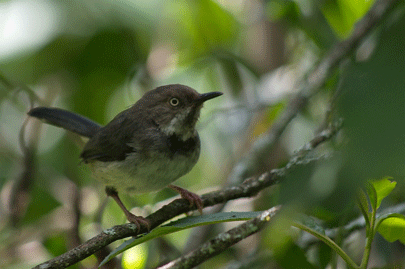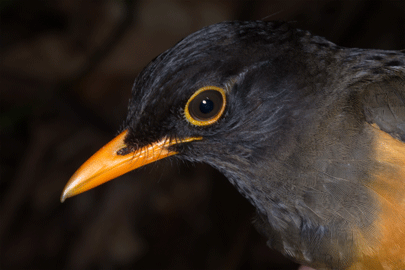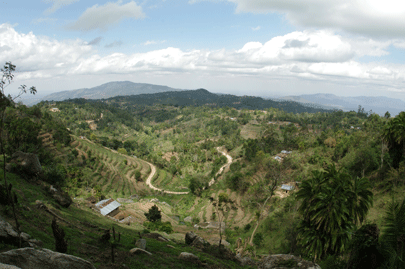The Vanishing Birds of the Taita hills
By Luca Borghesio and Mwangi Githiru
 |
|
Taita apalis female. Photo credit: Luca Borghesio. |
The Taita hills are a mountain massif in southern Kenya. Elevations are not impressive, as they don't go beyond 2,300m, but this small rocky outcrop hosts a trove of unique biodiversity, due to several million years of stable, wet climate and complete ecological isolation. Several plants, reptiles, amphibians, invertebrates and two species of birds are endemic to the Taita.
Unfortunately, the stable wet climate is good for the forest and agriculture as well, so unsurprisingly the Taita hills have been settled-in with densities of up to 1,000 people/km². The resultant human disturbances have led to more than 95% habitat loss and only about 15 small fragments of indigenous vegetation survive. The largest one is less than 250ha and the total sums up to little more than 500ha (the size of Central Park in New York).
The Taita hills are a conservation biologist's nightmare. Most of the endemic species have been reduced to small populations in steep declines. The statuses of the two endemic birds are emblematic. Both the Taita apalis and thrush are critically endangered in the IUCN Red List, and both have global ranges of less than 500ha.
Taita apalis (Apalis fuscigularis) currently survives in just four habitat fragments, with a global population of only 200 individuals. In less than two decades it has decreased by 60%, and it has disappeared from three out of seven fragments where it occurred in year 2000 (Borghesio et al., 2010).
Taita thrush (Turdus helleri) is less well known than Taita apalis, but recent assessments suggest dramatic and rapid decrease as well. Its global population probably ranges between 500 and 1000 individuals, and is restricted to just four forest fragments, two of which support only 2-3 pairs each. Moreover, sex ratios are severely male-skewed in some habitat fragments (Lens et al., 1998), probably due to intense predation on females as they brood. Unbalanced sex ratios suggest that in Taita thrush, due to a shortage of females, effective population size (i.e. the number of individuals that really breed in a population) is much lower than the actual number of individuals. These numbers are certainly not compatible with long term survival.
Our research in the last ten years has documented a rapid decline of the Taita endemic birds, especially of Taita apalis, whose population suffered a major drop in 2009, when a drought struck the Taita hills as well as most of Kenya (Borghesio et al., 2014). Another major drought occurred during the 2016-2017 breeding season, which was very poor for both the appalls and the thrush. If climate change could be a causal factor in the negative trend of the two species is still uncertain, but we suspect that two major droughts in less than ten years should be a rather uncommon scenario in a place where climatic modeling showed that stable wet conditions have prevailed for several millions of years (Fjeldsaå et al., 1997).
 |
|
Taita thrush. Photo credit: Luca Borghesio. |
Whether climate change can be imputed or not, the predicament of the Taita endemic birds can’t be blamed on only one factor as numerous clues suggest a complex picture of multiple concurrent threats. High rates of nest predation are certainly one component, because as much as 90% of the nests can be lost to various species of indigenous predators at some sites. Interestingly, a recent study found nest predation in the Taita to be more intense in larger, better preserved, rather than smaller, more disturbed, forest fragments, and far from forest edges rather than close to them (Spanhove et al., 2014).
The explanation of this surprising effect might be that the most important bird nest predators are indigenous, forest specialist species, rather than open habitat species invading the forest from outside, as is the usual case in fragmented landscapes. This interpretation has been confirmed by recent nest monitoring with automated cameras (Borghesio, Jensen and Githiru, pers. comm), which suggest that forest raptors, especially the African goshawk (Accipiter tachiro) could be responsible for most of the predation on Taita apalis nests.
Human disturbance is also a significant cause of nest loss for Taita apalis that nest in the lower vegetation layers and in canopy gaps where domestic cows are often grazed during the dry season. In Vuria fragment, the Apalis main stronghold, up to 20% of the nests have been lost due to cow trampling in 2016 and 2017 breeding seasons. On the other hand, Taita thrush is more of a forest interior specialist, and it rapidly disappears where the forest is disturbed by illegal timber and firewood collection. The sensitivity of Taita thrush to habitat disturbance has been studied in a series of brilliant studies, showing the strong link between habitat disturbance, fluctuating asymmetry and adult survival in the thrush and other species (Lens et al., 2002).
A GIS modeling exercise has prioritized the Taita landscape (Githiru et al., 2011) and the most appropriate techniques for restoring indigenous forest and biological connectivity. The GIS modeling stressed the importance of Yale and Vuria-Msidunyi habitat fragments, both as primal stepping stones for ecological connectivity and as key sites for some of the most important and highly threatened populations of Taita apalis and Taita thrush. Nature Kenya, the BirdLife partner in Kenya, has recently obtained a grant from the Rainforest Trust to purchase plots of land in Misdone. These plots will secure a highly threatened and currently unprotected subpopulation of Taita apalis that we discovered in 2011 (Borghesio and Yagura, 2012).
A plan to eradicate invasive plants and restore nesting habitat is ongoing for both Taita apalis and Taita thrush, who currently survive with only 1-3 pairs in a tiny remnant of indigenous forest embedded in a much larger area of Eucalyptus plantation and bush carpeted by the invasive Acacia mearnsii. Further restoration efforts are focused on strategically located patches of exotic tree plantations in Ngangao forest, another apalis and thrush stronghold.
As the clock ticks, time is running short for the Taita endemic birds. A major effort will be required to avert these impending extinctions. Fortunately, good research is giving a new impetus for their conservation.
 |
|
Terrace cultivation in Taita hills. Photo credit: Luca Borghesio. |
Acknowledgments
The Taita hills Critically Endangered Birds Project is a collaboration between several individuals and NGOs. The authors thank Mwangi Githiru, Lawrence Wagura, Maina Gichia, Cosmas Mgange, Nathaniel Ndigila, Rie Jensen and Nathaniel Waweru.
Thanks also to Nature Kenya, BirdLife partner in Kenya, who executed this project with assistance from the RSPB (UK). Grants from Rainforest Trust, the Mohammed bin Zayed Species Conservation Fund, the African Bird Club and NABU are hereby acknowledged.
References
Borghesio, L., Samba, D., Githiru, M., Bennun, L., Norris, K., 2010. Population estimates and habitat use by the Critically Endangered Taita Apalis Apalis fuscigularis in south-eastern Kenya. Bird Conserv. Int. 20, 440–455. doi:10.1017/S0959270910000298
Borghesio, L., Wagura, L., 2012. In an era of deforestation, a forest fragment found. Swara Jan-Mar 2012, 57–59.
Borghesio, L., kagura, L., Samba, D., Githiru, M., 2014. Drifting into extinction: results from the long-term monitoring of Taita apalis Apalis fuscigularis, in: Gereau, R.E. (Ed.), Biodiversity Status and Trends in the Eastern Arc Mountains and Coastal Forests of Kenya and Tanzania Region, 2008-2013. BirdLife International, Nairobi, Kenya, pp. 68–71.
Fjeldsaå, J., Ehrlich, D., Lambkin, E., Prins, E., 1997. Are biodiversity ‘hotspots’ correlated with current ecoclimatic stability? A pilot study using the NOAA-AVHRR remote sensing data. Biodivers. Conserv. 6, 401–422.
Githiru, M., Lens, L., Adriaensen, F., Mwang’ombe, J., Mathison, E., 2011. Using science to guide conservation: From landscape modelling to increased connectivity in the Taita Hills, SE Kenya. J. Nat. Conserv. 19, 263–268. doi: 10.1016/j.jnc.2011.03.002
Lens, L., Galbusera, P., Brooks, T., Waiyaki, E., Schenck, T., 1998. Highly skewed sex ratios in the critically endangered Taita thrush as revealed by CHD genes. Biodivers. Conserved. 7, 869–873.
Lens, L., Van Dongen, S., Matthysen, E., 2002. Fluctuating asymmetry as an early warning system in the critically endangered Taita Thrush. Conserv. Biol. 16, 479–487.
Spanhove, T., Callens, T., Hollmann, C.A., Palicki, P., Lens, L., 2014. Nest predation in Afrotropical forest fragments shaped by inverse edge effects, timing of nest initiation and vegetation structure. J. Ornithol. 155, 411–420. doi:10.1007/s10336-013-1021-9